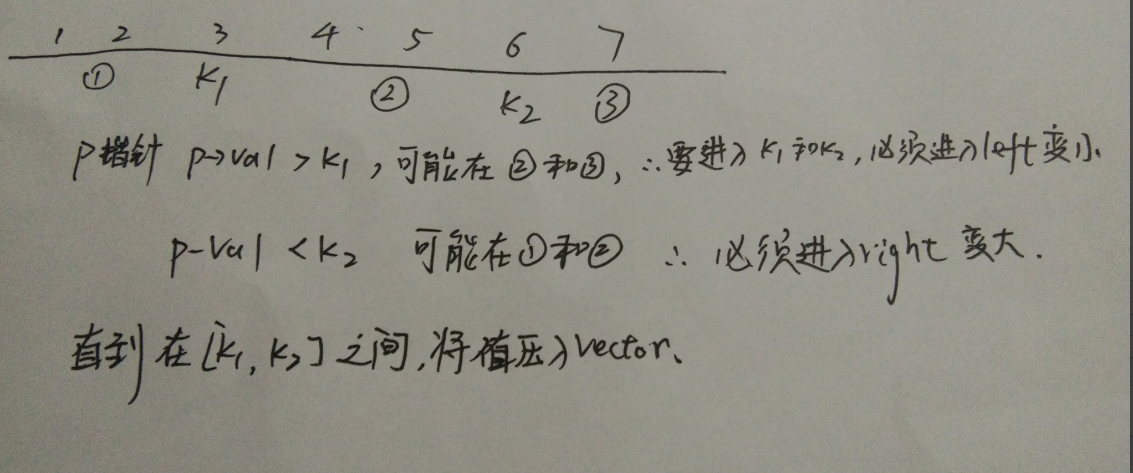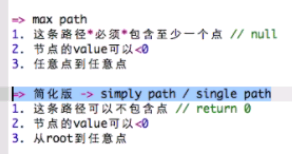专题2 二叉树(go)
1、 需要记忆的部分:
分治法的基本思想是将一个规模为n 的问题分解为k 个规模较小的子问题,这些子问题互相独立且与原问题相同。递归的解这些子问题,然后将各子问题的解合并得到原问题的解。
对于二叉树问题,首先需要熟练记住二叉树的前序中序遍历的递归版本和迭代版本,后序也可以看一下,记住BFS的实现过程,归并排序,快速排序,二叉搜索树BST。
完全二叉树:左右节点高度差不能超过1;
二叉搜索树:root左边的节点都小于root,root右边的节点都大于root的值。判断标准是:中序遍历是一个增序列。
AVL平衡二叉树:它是一棵空树或它的左右两个子树的高度差的绝对值不超过1,并且左右两个子树都是一棵平衡二叉树。
总结:
1)二叉树问题基本都是考察递归,几乎所有的二叉树问题时间复杂度都是O(N),空间复杂度和二叉树的高度有关系,因为每一次递归都需要系统内存开一个栈空间进行存储,
2)其中递归函数中使用void的函数是遍历版本,使用有返回值的函数是分治版本,使用全局变量会影响多线程,
3)helper函数是在递归中使用的,因为原有的函数可能只返回一个值,而中间的递归过程需要返回多个值,此时就需要再写一个helper函数
4)在求最大值问题时候,非法情况需要些root = NULL,此时返回一个负无穷大;
再求最小值问题的时候,此时返回一个正无穷大。
写分治自己的感悟是,先想想最简单的情况是怎么写的。
二叉树问题思考过程:首先r思考递归基的情况root ==NULL,return;
然后思考左右子树递归完有什么实际意义,然后分别进行处理;
2、下面是二叉树问题的模板:
1)遍历形式的模板;
 Template 1: Traverse
Template 1: Traverse
2)divide and conquer模板
 View Code
View Code
注意:this是指针,谁调用struct新建变量,this就指向这个变量,它是个指针记住,所以使用->;
struct 后面接变量不加括号,最后需要加分号;,初始化方法有三种,列表初始化1,自己构造的不能使用new,再新建变量。
struct resultType{
int singlePath;
int maxPath;
// 1=> resultType(int x,int y):singlePath(x),maxPath(y){ }
// 2 => resultType(int x,int y){
// singlePath = x;
// maxPath = y;
// }
resultType(int x,int y){
this -> singlePath = x;
this -> maxPath = y;
}
};
使用new的时候必须要记得,在自由分配的内存是无名的,因此new无法为其分配的对象命名,而是返回一个指向该对象的指针,所以new的时候,前面必须是指针。
resultType* result = new resultType(0,INT_MIN);//必须要加*
3、二叉树分治法题目
深度优先搜索DFS:
3.1 Lowest Common Ancestor
https://leetcode.com/problems/lowest-common-ancestor-of-a-binary-tree/#/description
思路:需要注意接口给出的变量里面必须要有root或者parent,不然该题没法做,
1)有parent的题目,首先遍历得到两个节点的父亲节点,存在两个vector或者list中,然后分别进行遍历比较,寻找第一个不同的节点,就是所求。
2)有root的题目,使用上述模板,注意分析,该节点是root就可以直接返回,a和b节点在左右子树,则返回root,只有一个节点在二叉树中,则直接返回该节点,都不在二叉树中,则返回NULL。
注意递归基的时候,只有某个节点等于root节点,那么就已经直接返回这个节点,自己也是自己的祖先。
// 在root为根的二叉树中找A,B的LCA:
// 如果找到了就返回这个LCA
// 如果只碰到A,就返回A
// 如果只碰到B,就返回B
// 如果都没有,就返回null

/**
* Definition for a binary tree node.
* type TreeNode struct {
* Val int
* Left *TreeNode
* Right *TreeNode
* }
*/
func lowestCommonAncestor(root, p, q *TreeNode) *TreeNode {
if root == nil || root == p || root == q{
return root
}
lTree := lowestCommonAncestor(root.Left, p, q)
rTree := lowestCommonAncestor(root.Right, p, q)
if lTree != nil && rTree != nil {
return root
}
if lTree != nil {
return lTree
}
if rTree != nil {
return rTree
}
return nil
}
235. Lowest Common Ancestor of a Binary Search Tree
https://leetcode.com/problems/lowest-common-ancestor-of-a-binary-search-tree/description/
使用递归可以轻松解决此问题。对于此题我们可以分为三种情况讨论:
1. P, Q都比root小,则LCA在左树,我们继续在左树中寻找LCA
2. P, Q都比root大,则LCA在右树,我们继续在右树中寻找LCA
3. 其它情况,表示P,Q在root两边,或者二者其一是root,或者都是root,这些情况表示root就是LCA,直接返回root即可。

/**
* Definition for a binary tree node.
* type TreeNode struct {
* Val int
* Left *TreeNode
* Right *TreeNode
* }
*/
func lowestCommonAncestor(root, p, q *TreeNode) *TreeNode {
if root == nil || root == p || root == q {
return root
}
if p.Val < root.Val && q.Val < root.Val {
return lowestCommonAncestor(root.Left, p, q)
} else if p.Val > root.Val && q.Val > root.Val {
return lowestCommonAncestor(root.Right, p, q)
} else {
return root
}
}
3.2 Maximum Depth of Binary Tree
https://leetcode.com/problems/maximum-depth-of-binary-tree/#/description
Given the root of a binary tree, return its maximum depth. A binary tree's maximum depth is the number of nodes along the longest path from the root node down to the farthest leaf node.
思路:递归到左右子树计算,看哪边深度大,关键理解最后一步每次返回到上一层都需要将深度增一。
根结点的深度是约定的,这道题目约定的是根节点的深度是1;根结点的深度是1,属于第1层。经过多少条边,深度就是多少。

/**
* Definition for a binary tree node.
* type TreeNode struct {
* Val int
* Left *TreeNode
* Right *TreeNode
* }
*/
func maxDepth(root *TreeNode) int {
if root == nil {
return 0
}
left := maxDepth(root.Left)
right := maxDepth(root.Right)
if left > right {
return left + 1
}
return right + 1
}
111. Minimum Depth of Binary Tree
https://leetcode.com/problems/minimum-depth-of-binary-tree/description/
这道题是树的题目,其实跟Maximum Depth of Binary Tree非常类似,只是这道题因为是判断最小深度,所以必须增加一个叶子的判断(因为如果一个节点如果只有左子树或者右子树,我们不能取它左右子树中小的作为深度,因为那样会是0,我们只有在叶子节点才能判断深度,而在求最大深度的时候,因为一定会取大的那个,所以不会有这个问题)。这道题同样是递归和非递归的解法,递归解法比较常规的思路,比Maximum Depth of Binary Tree多加一个左右子树的判断.

/**
* Definition for a binary tree node.
* type TreeNode struct {
* Val int
* Left *TreeNode
* Right *TreeNode
* }
*/
func minDepth(root *TreeNode) int {
if root == nil {
return 0
}
if root.Left == nil {
return minDepth(root.Right) + 1
}
if root.Right == nil {
return minDepth(root.Left) + 1
}
return min(minDepth(root.Left), minDepth(root.Right)) + 1
}
func min(a, b int) int {
if a < b {
return a
}
return b
}
3.3 Balanced Binary Tree
https://leetcode.com/problems/balanced-binary-tree/#/description
思路:基于二叉树最大深度那题,当左右子树深度大于1的时候深度返回-1这步是关键

/**
* Definition for a binary tree node.
* type TreeNode struct {
* Val int
* Left *TreeNode
* Right *TreeNode
* }
*/
func maxDepth(root *TreeNode) int {
if root == nil {
return 0
}
//不平衡的时候用-1表示
left := maxDepth(root.Left)
right := maxDepth(root.Right)
if left == -1 || right == -1 || abs(left - right) > 1 {
return -1
}
return max(left, right) + 1
}
func max(a, b int) int {
if a < b {
return b
}
return a
}
func abs(c int) int {
if c < 0 {
return -c
}
return c
}
func isBalanced(root *TreeNode) bool {
if root == nil {
return true
}
return maxDepth(root) != -1
}
4 宽度优先搜搜BFS
4,.1 Binary Tree Level Order Traversal (*)
https://leetcode.com/problems/binary-tree-level-order-traversal/#/description
Given the root of a binary tree, return the level order traversal of its nodes' values. (i.e., from left to right, level by level).
思路:二叉树的层次遍历就是宽度优先搜索,总共有三种实现方式,
- 2 Queues(一个存parent,一个存儿子节点,每次都需要清空一个queue)
- 1 Queue + Dummy Node(每个虚拟节点代表该层结束)
- 1 Queue (best)
这里需要注意,首先将root节点入栈,接下来是双循环,外层是队列不为空,内层是遍历每一层,进入内层循环之前要使用一个int记录队列的大小,代表该层节点个数。

/**
* Definition for a binary tree node.
* type TreeNode struct {
* Val int
* Left *TreeNode
* Right *TreeNode
* }
*/
func levelOrder(root *TreeNode) [][]int {
if root == nil {
return [][]int{}
}
queue := []*TreeNode{root}
res := [][]int{}
for len(queue) != 0 {
curRes := []int{}
newQueue := []*TreeNode{}
for _, node := range queue {
curRes = append(curRes, node.Val)
if node.Left != nil {
newQueue = append(newQueue, node.Left)
}
if node.Right != nil {
newQueue = append(newQueue, node.Right)
}
}
res = append(res, curRes)
queue = newQueue
}
return res
}
5 二叉搜索树 Binary Search Tree
5.1 Validate Binary Search Tree
https://leetcode.com/problems/validate-binary-search-tree/#/description
Given the root of a binary tree, determine if it is a valid binary search tree (BST).
A valid BST is defined as follows:
- The left subtree of a node contains only nodes with keys less than the node's key.
- The right subtree of a node contains only nodes with keys greater than the node's key.
- Both the left and right subtrees must also be binary search trees.
思路:验证是否是二叉搜索树,使用中序遍历,如果是递增序列,那么就是二叉搜索树。平衡二叉树:root为空也是二叉搜索树,每个元素不相等,左边小于root,右边大于root;
切片的传递,&arr,这样才能修改切片的值,引用类型指的是引用底层的数组。

/**
* Definition for a binary tree node.
* type TreeNode struct {
* Val int
* Left *TreeNode
* Right *TreeNode
* }
*/
func helper(root *TreeNode, res *[]int) {
if root != nil {
helper(root.Left, res)
*res = append(*res, root.Val)
helper(root.Right, res)
}
}
func isValidBST(root *TreeNode) bool {
if root == nil {
return true
}
res := []int{}
helper(root, &res)
for i:= 0; i < len(res) - 1;i++ {
if res[i] >= res[i + 1] {
return false
}
}
return true
}
5.2 Insert Node in a Binary Search Tree
http://www.lintcode.com/en/problem/insert-node-in-a-binary-search-tree/
思路:记住需要插入的节点一定是在二叉树某个叶子节点下面插入的(这里是理解重点),就是递归到递归基的时候,还有就是记得左右递归的if条件。
 insert Node
insert Node5.3 Search Range in Binary Search Tree
http://www.lintcode.com/en/problem/search-range-in-binary-search-tree/
思路:注意递归的时候如果比k1大,就进入左子树,如果比k2小,就进行右子树。在两者之间,就压入result数组。

 search Range
search Range6.124. Binary Tree Maximum Path Sum
https://leetcode.com/problems/binary-tree-maximum-path-sum/#/description
思路:先思考一个简化版的情况,然后再思考该题。该题最大路径和可能在左子树,可能在右子树,可能是左子树的节点经过root然后到右子树的节点。
root等于空的时候是非法情况,求最大就需要返回最小,求最小就需要返回最大值。自己定义一个struct,里面包含两个值,一个是简化版的single path,一个是该题的max path。。
接下来进行分治,首先分:想左子树右子树递归完分别希望得到什么结果,接下来治:分别求出single path 和max path。

 使用new的版本
使用new的版本 maxPath
maxPath
7.129. Sum Root to Leaf Numbers
https://leetcode.com/problems/sum-root-to-leaf-numbers/#/description
You are given the root of a binary tree containing digits from 0 to 9 only.
Each root-to-leaf path in the tree represents a number.
- For example, the root-to-leaf path
1 -> 2 -> 3represents the number123.
Return the total sum of all root-to-leaf numbers.
A leaf node is a node with no children.
The root-to-leaf path 1->2 represents the number 12.
The root-to-leaf path 1->3 represents the number 13.
Return the sum = 12 + 13 = 25.
思路:这题还是不怎么理解,采用的是自顶向下的递归设计,所以sum = 目前值加上10倍前面的值,最后返回的时候需要将左右子树的值相加放回。因为每次都需要将sum传递给下一个递归函数,所以首先对sum进行计算,已经到达叶子节点则该路径的值以及计算出来,需要将值返回,不是叶子结点的话,就需要将左右子树的值加起来返回。

func sumNumbers(root *TreeNode) int { sum := 0 var s func(*TreeNode, int) s = func(root *TreeNode, total int) { if root == nil {return} if root.Left == nil && root.Right == nil { sum += (total * 10) + root.Val return } total = ((total * 10) + root.Val) s(root.Left, total) s(root.Right, total) } s(root, 0) return sum }
8.112. Path Sum
https://leetcode.com/problems/path-sum/#/description
是否存在一条路径等于指定的sum

/**
* Definition for a binary tree node.
* type TreeNode struct {
* Val int
* Left *TreeNode
* Right *TreeNode
* }
*/
func hasPathSum(root *TreeNode, targetSum int) bool {
if root == nil {
return false
}
if root.Left == nil && root.Right == nil {
return root.Val == targetSum
}
return hasPathSum(root.Left, targetSum - root.Val) ||
hasPathSum(root.Right, targetSum - root.Val)
}
9.173. Binary Search Tree Iterator
https://leetcode.com/problems/binary-search-tree-iterator/#/description
Implement an iterator over a binary search tree (BST). Your iterator will be initialized with the root node of a BST.
Calling next() will return the next smallest number in the BST.
Note: next() and hasNext() should run in average O(1) time and uses O(h) memory, where h is the height of the tree.
思路:其实就是中序遍历迭代版,这题要看清题目,是二叉搜索树,左<中<右;遍历到最左边就是最小的元素。
https://leetcode-cn.com/problems/binary-tree-inorder-traversal/solution/er-cha-shu-de-zhong-xu-bian-li-by-leetcode-solutio/

type BSTIterator struct {
stack []*TreeNode
cur *TreeNode
}
func Constructor(root *TreeNode) BSTIterator {
return BSTIterator{cur: root}
}
func (it *BSTIterator) Next() int {
for node := it.cur; node != nil; node = node.Left {
it.stack = append(it.stack, node)
}
it.cur, it.stack = it.stack[len(it.stack)-1], it.stack[:len(it.stack)-1]
val := it.cur.Val
it.cur = it.cur.Right
return val
}
func (it *BSTIterator) HasNext() bool {
return it.cur != nil || len(it.stack) > 0
}






